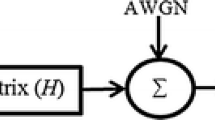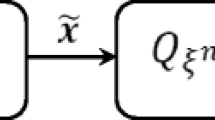Abstract
This paper presents the effects of condition number (\(\tau \)) in communication system performance. It has been shown that a small condition number (\(\tau \)) results a better performance. The proposed scheme is using special kind of matrices with Lattice Sphere Decoding (LSD) technique for Block Data Transmission Systems (BDTS). Hankel and Toeplitz matrices are used separately as a channel matrix (H) while circulant matrix is used in the previous works. The proposed scheme reduced the condition number (\(\tau \)) and, therefore, improve the system performance. As a result; LSD-based BDTS with Toeplitz/Hankel matrix outperforms the LSD-based BDTS with circulant matrix. Complexity analysis is also done which based on lattice dimension and initial radius selection.






Similar content being viewed by others
References
Babu, S. P. K., Salleh, M. F. M., & Ghani, F. (2009). Reduced complexity optimum detector for block data transmission systems. IEICE Electronics Express (ELEX), 6(23), 1649–1655.
Li, X., & Cui, X. (2004). Application of lattice code decoder to SC-CP for short block length. Electronics Letters, 40(15), 954–955.
Albreem, M. A. M., Salleh, M. F. M., & Babu, S. P. K. (2011). Reduced complexity optimum detector for block data transmission systems using lattice sphere decoding technique. IEICE Electronics Express (ELEX), 8(9), 644–649.
Barbero, L. G., & Thompson, J. S. (2008). Fixing the complexity of the sphere decoder for MIMO detection. IEEE Transactions on Wireless Communications, 7(6), 2131–2143.
Kreyszig, E. (2011). Advanced engineering mathematircs (10th ed., pp. 861–867). New York: Wiley.
Conway, J. H., & Sloane, N. J. A. (1999). Sphere packings, lattices and goups. Berlin: Springer.
Roger, S., Gonzalez, A., Almenar, V., & Vidal, A. (2009). MIMO channel matrix condition number estimation and threshold selection for combined K-best sphere decoders. IEICE Transactions on Communications, E92–B(4), 1380–1383.
Higham, D. J. (1995). Condition numbers and their condition numbers. Linear Algebra and its Application, 214, 193–213.
Cui, T., & Tellambura, C. (2005). An efficient generalized sphere decoder for rank-deficient MIMO systems. IEEE Communication Letters, 9(5), 423–425.
Hassibi, B., & Vikalo, H. (2005). On the sphere-decoding algorithm I. Expected complexity. IEEE Transactions on Signal Processing, 53(8), 2806–2818.
Dianat, S. A., & Saber, E. S. (2009). Advanced Linear Algebra for Engineers with MATLAB (1st ed.). Bacoraton, FL: CRC Press.
Ramamurthy, G. (July 2009). Left circulant and generator type matrices, Report No: IIIT/TR/2009/155. Theory and Algorithms International Institute of Information Technology, India: Centre for Security.
Albreem, M. A. M., & Salleh, M. F. M. (2013). Near-\(A_n\)-lattice sphere decoding technique assisted optimum detection for block data transmission systems. IEICE Transactions on Communications, E96–B(1), 356–359.
Yang, L., Chen, R. S., Soo, K. K., & Siu, Y. M. (2007). An efficient sphere decoding approach for PTS assisted PAPR reduction of OFDM signals. International Journal of Electronics and Communications (AEÜ), 61, 684–688.
Tse, D., & Viswanath, P. (2005). Fundamental of wireless communication. Cambridge: Cambridge University Press.
Lee, E. A. (1994). Digital communication. London: Kluwer Academic.
Acknowledgments
The authors would like to thank the Universiti Sains Malaysia (USM) for the financial supports and fellowship.
Author information
Authors and Affiliations
Corresponding author
Rights and permissions
About this article
Cite this article
Albreem, M.A.M., Salleh, M.F.M. Lattice Sphere Decoding for Data Transmission Systems with Special Channel Matrices. Wireless Pers Commun 79, 265–277 (2014). https://doi.org/10.1007/s11277-014-1855-3
Published:
Issue Date:
DOI: https://doi.org/10.1007/s11277-014-1855-3




